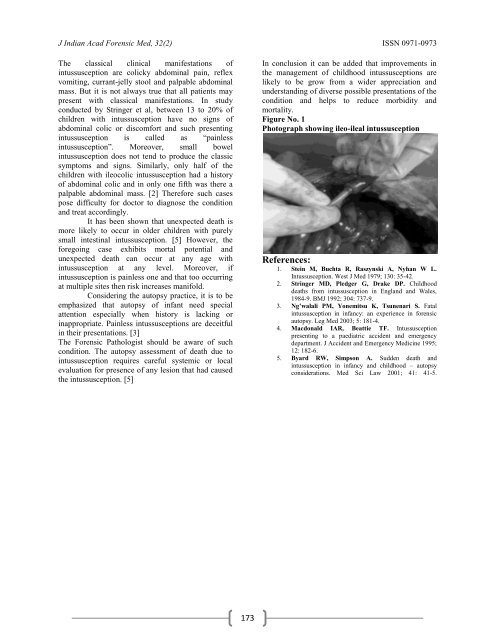ISSN 0971-0973 J Indian Acad Forensic Med, <strong>32</strong>(2)Case ReportFatal Multiple Painless Intussusceptions: A Case Report*Nilesh Keshav Tumram, MD, **Rajesh Vaijnathrao Bardale, MD, ***Manish B Shrigiriwar, MDAbstractIntussusception is an invagination of the intestine into another in the direction of peristalsis. Because ofvaried presentations and relative rarity, intussusception remains a difficult condition to diagnose and at times it maybe missed altogether. It is a commonest cause of intestinal obstruction in infancy and childhood though morbidityand mortality rates from the condition have progressively declined in recent times, still avoidable deaths continues.Here we present a case of female child of 3 months brought for <strong>forensic</strong> autopsy after her death with history of feverand cough since 2 days and breathlessness since 1 day. Autopsy revealed three intussusceptions. Painlessintussusceptions are deceitful in their presentations. The <strong>forensic</strong> pathologist should be aware of such condition. Thecurrent case report exhibits such diagnostic pitfall and highlights the importance of <strong>forensic</strong> autopsy in revealing thecause of death.Key Words: Intussusception, Death, Infant, Cause of Death, Autopsy, Forensic PathologistIntroduction:Intussusception is an invagination of theintestine into another in the direction of peristalsis.[1] It is the commonest cause of intestinal obstructionin young children, two thirds of cases occurring ininfancy. [2] Although morbidity and mortality ratesfrom the condition have progressively declined inrecent decades but avoidable deaths still occurs. [3,4]Because of varied presentations and relativerarity, intussusception remains a difficult condition todiagnose. Moreover, in case of “painlessintussusception”, diagnosis not only becomesdifficult but there is very chance that the conditionmay be missed altogether. Such case may be referredto <strong>forensic</strong> pathologist as a case of sudden death. Thecurrent case report exhibits such diagnostic pitfalland highlights the importance of <strong>forensic</strong> autopsy inrevealing the cause of death.Case report:A 3-month-old female infant wasreferred to Forensic Autopsy at Indira Gandhi Govt.Medical College, Nagpur.Corresponding Author:*Dr Nilesh Keshav TumramLecturer, Dept. of Forensic MedicineGovt. Medical College & HospitalNagpur –440 003Maharashtra, (India)Phone No. 919422819766Email: ntumram@rediffmail.com**Lecturer***Associate ProfessorPatient was admitted for 12 hours at Govt.Medical College, Nagpur with history of fever andcough from past two days and breathlessness fromone day. Her birth history was uneventful. Nosignificant past and family history. On physicalexamination, the general condition was notsatisfactory. She was hypothermic with toxic look.Her pulse rate was 100/minute and respiratory rate30/minute. Her abdomen was noted to be soft.Peripheral blood smear revealed microcytic plusmacrocytic cells. Total leucocytic count was11000/cu mm, differential count revealed –polymorphs 70%, lymphocytes 28%, monocytes andeosinophils 1% respectively.At autopsy, her weight was 3.75 Kg, length52 cm, head circumference 37 cm and chestcircumference 34 cm. External examination revealedno injuries except for those from clinical proceduresand resuscitative measures. Internal examinationshowed edematous brain with white matter studdedwith petechial hemorrhages. Lungs showed evidenceof patchy consolidation. Heart was unremarkable.The peritoneal cavity contains 500 ml reddish colourfluid. Three intussusceptions were noted; first andsecond were ileo-ileal Fig No.1 and third one wasileo-cecal. Other abdominal organs were congested.Toxicological screening was negative for poison.Discussion:Intussusception may occur spontaneously ormay be associated with an anatomic lesion such as –enlarged mesenteric nodes, hypertrophphied peyerpatches, Meckel diverticulum, polyp, enteric cyst,intramural hematoma, ileal duplication,lymphosarcoma, inspissated meconium associatedwith cystic fibrosis and Henoch-Schonloin purpura.172
J Indian Acad Forensic Med, <strong>32</strong>(2) ISSN 0971-0973The classical clinical manifestations ofintussusception are colicky abdominal pain, reflexvomiting, currant-jelly stool and palpable abdominalmass. But it is not always true that all patients maypresent with classical manifestations. In studyconducted by Stringer et al, between 13 to 20% ofchildren with intussusception have no signs ofabdominal colic or discomfort and such presentingintussusception is called as “painlessintussusception”. Moreover, small bowelintussusception does not tend to produce the classicsymptoms and signs. Similarly, only half of thechildren with ileocolic intussusception had a historyof abdominal colic and in only one fifth was there apalpable abdominal mass. [2] Therefore such casespose difficulty for doctor to diagnose the conditionand treat accordingly.It has been shown that unexpected death ismore likely to occur in older children with purelysmall intestinal intussusception. [5] However, theforegoing case exhibits mortal potential andunexpected death can occur at any age withintussusception at any level. Moreover, ifintussusception is painless one and that too occurringat multiple sites then risk increases manifold.Considering the autopsy practice, it is to beemphasized that autopsy of infant need specialattention especially when history is lacking orinappropriate. Painless intussusceptions are deceitfulin their presentations. [3]The Forensic Pathologist should be aware of suchcondition. The autopsy assessment of death due tointussusception requires careful systemic or localevaluation for presence of any lesion that had causedthe intussusception. [5]In conclusion it can be added that improvements inthe management of childhood intussusceptions arelikely to be grow from a wider appreciation andunderstanding of diverse possible presentations of thecondition and helps to reduce morbidity andmortality.Figure No. 1Photograph showing ileo-ileal intussusceptionReferences:1. Stein M, Buchta R, Raszynski A, Nyhan W L.Intussusception. West J Med 1979; 130: 35-42.2. Stringer MD, Pledger G, Drake DP. Childhooddeaths from intussusception in England and Wales,1984-9. BMJ 1992; 304: 737-9.3. Ng‟walali PM, Yonemitsu K, Tsunenari S. Fatalintussusception in infancy: an experience in <strong>forensic</strong>autopsy. Leg Med 2003; 5: 181-4.4. Macdonald IAR, Beattie TF. Intussusceptionpresenting to a paediatric accident and emergencydepartment. J Accident and Emergency Medicine 1995;12: 182-6.5. Byard RW, Simpson A. Sudden death andintussusception in infancy and childhood – autopsyconsiderations. Med Sci Law 2001; 41: 41-5.173



![syllabus in forensic medicine for m.b.b.s. students in india [pdf]](https://img.yumpu.com/48405011/1/190x245/syllabus-in-forensic-medicine-for-mbbs-students-in-india-pdf.jpg?quality=85)



![SPOTTING IN FORENSIC MEDICINE [pdf]](https://img.yumpu.com/45856557/1/190x245/spotting-in-forensic-medicine-pdf.jpg?quality=85)

![JAFM-33-2, April-June, 2011 [PDF] - forensic medicine](https://img.yumpu.com/43461356/1/190x245/jafm-33-2-april-june-2011-pdf-forensic-medicine.jpg?quality=85)



![JIAFM-33-4, October-December, 2011 [PDF] - forensic medicine](https://img.yumpu.com/31013278/1/190x245/jiafm-33-4-october-december-2011-pdf-forensic-medicine.jpg?quality=85)


